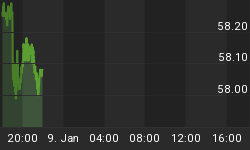Valid Concern About Market's Rapid Ascent
The following logical question was posed on Twitter this morning:

The short answer is "yes, it is a relevant concern looking out days/weeks." However, it is also worth taking a look at some historical examples. History helps us keep an open mind about all outcomes (bullish and bearish). Therefore, in today's post, we will answer one question and one question only:
Is The Distance Between The S&P 500 And Its 50-Day A Showstopper?
White Space Between Price And 50-Day
The S&P 500 broke above its 50-day moving average 28 calendar days ago.

Since then, it has risen at a rapid pace, leaving the 50-day in the rearview mirror. The 2015 market has three characteristics that allow for a historical comparison:
- A waterfall plunge in August.
- A double bottom (more details).
- A bullish reversal in the 50-day's slope.

Can We Find A Similar Historical Example?
The answer to the question above is "yes". In 1998, the market had a waterfall plunge, a double bottom, and quite a bit of white space between a rising 50-day moving average and the S&P 500 (price).

The charts below are not a commentary on 2015, nor is it a comparison of 1998 and 2015. Remember, the purpose of the exercise was to answer one question. We understand "1998 was different". That argument applies to all historical references made about the economy and markets. No two periods in human history are alike.

What Happened Next In 1998?
In 1998, rather than "filling the white space" and returning to the 50-day moving average, the S&P 500 rallied for several months in 1998 before revisiting the 50-day in February 1999.

1998: Did The Rally End Near The 50-Day?
The answer to the question above is "no", stocks continued to rally until July 1999. Notice during the latter stages of the rally price did tend to congregate around the 50-day moving average.

1998: Did Overhead Supply Kill The Rally?
Overhead supply was and still is a concern in 2015. As we outlined in this October 9 video clip, like the white space issued covered above, overhead supply is not necessarily a showstopper either. The market was able to overcome three pockets of overhead supply in 1998.

Can We Find Another Historical Example?
Many may remember the feeling that "the market has to pull back" in the early stages of the March 2009 rally. The market did not comply, failing to revisit the 50-day moving average for 91 calendar days. Keep in mind, we are at day 28 in 2015.

But 2015 Is Laced With Problems, Right?
Yes, that is a fair argument, one that was made in 1998 and 2009 as well. Is there any evidence that supports the possibility of a 1998-like rally in stocks? Yes, the following links will take you to dated pieces of evidence that tell us to keep an open mind about better than expected outcomes in 2015:
- Key reversal bullet points - October 2, 2015.
- Breadth thrust - October 9, 2015.
- DeMark trend signals (TDST) - October 16, 2015.
- Runaway gaps - October 23, 2015.
- Gaps held on bad news - October 30, 2015.
How Can This Help Us?
If you feel very skeptical about the possibility of a continued rally in stocks and have felt skeptical since the October 2 intraday reversal, that is common near turning points. The purpose of this analysis is not to predict anything, but rather to help us keep an open mind about both better than expected outcomes and worse than expected outcomes. The charts, price, and hard data will guide us if we are willing to listen with a flexible, unbiased, and open mind. As you look at the 1998 chart below, keep in mind we have a waterfall decline in 2015, a double bottom, overhead supply concerns, and a sharp rally.

















